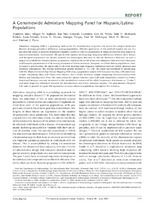A genomewide admixture mapping panel for hispanic/latino populations

View/
Date
2007-06Author
Xianyun, Mao
Bigham, Abigail W
Mei, Rui
Gutiérrez, Gerardo
Weiss, Ken M
Brutsaert, Tom D
León-Velarde, Fabiola
Moore, Lorna G
Vargas, Enrique
McKeigue, Paul M
Shriver, Mark D
Parra, Esteban J
Metadata
Show full item recordAbstract
Admixture mapping (AM) is a promising method for the identification of genetic risk factors for complex traits and
diseases showing prevalence differences among populations. Efficient application of this method requires the use of a
genomewide panel of ancestry-informative markers (AIMs) to infer the population of origin of chromosomal regions in
admixed individuals. Genomewide AM panels with markers showing high frequency differences between West African
and European populations are already available for disease-gene discovery in African Americans. However, no such a
map is yet available for Hispanic/Latino populations, which are the result of two-way admixture between Native American and European populations or of three-way admixture of Native American, European, and West African populations. Here, we report a genomewide AM panel with 2,120 AIMs showing high frequency differences between Native American and European populations. The average intermarker genetic distance is ∼1.7 cM. The panel was identified by genotyping, with the Affymetrix GeneChip Human Mapping 500K array, a population sample with European ancestry, a Mesoamerican sample comprising Maya and Nahua from Mexico, and a South American sample comprising Aymara/Quechua from Bolivia and Quechua from Peru. The main criteria for marker selection were both high information content for Native American/European ancestry (measured as the standardized variance of the allele frequencies, also known as “f value”) and small frequency differences between the Mesoamerican and South American samples. This genomewide AM panel will make it possible to apply AM approaches in many admixed populations throughout the Americas.
